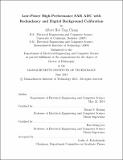| dc.contributor.advisor | Duane S. Boning and Hae-Seung Lee. | en_US |
| dc.contributor.author | Chang, Albert Hsu Ting | en_US |
| dc.contributor.other | Massachusetts Institute of Technology. Department of Electrical Engineering and Computer Science. | en_US |
| dc.date.accessioned | 2013-11-18T17:36:10Z | |
| dc.date.available | 2013-11-18T17:36:10Z | |
| dc.date.copyright | 2013 | en_US |
| dc.date.issued | 2013 | en_US |
| dc.identifier.uri | http://hdl.handle.net/1721.1/82177 | |
| dc.description | Thesis (Ph. D.)--Massachusetts Institute of Technology, Dept. of Electrical Engineering and Computer Science, 2013. | en_US |
| dc.description | This electronic version was submitted by the student author. The certified thesis is available in the Institute Archives and Special Collections. | en_US |
| dc.description | Cataloged from student-submitted PDF version of thesis. | en_US |
| dc.description | Includes bibliographical references (p. 195-199). | en_US |
| dc.description.abstract | As technology scales, the improved speed and energy eciency make the successive- approximation-register (SAR) architecture an attractive alternative for applications that require high-speed and high-accuracy analog-to-digital converters (ADCs). In SAR ADCs, the key linearity and speed limiting factors are capacitor mismatch and incomplete digital-to-analog converter (DAC)/reference voltage settling. In this the- sis, a sub-radix-2 SAR ADC is presented with several new contributions. The main contributions include investigation of using digital error correction (redundancy) in SAR ADCs for dynamic error correction and speed improvement, development of two new calibration algorithms to digitally correct for manufacturing mismatches, design of new architecture to incorporate redundancy within the architecture itself while achieving 94% better energy eciency compared to conventional switching algorithm, development of a new capacitor DAC structure to improve the SNR by four times with improved matching, joint design of the analog and digital circuits to create an asynchronous platform in order to reach the targeted performance, and analysis of key circuit blocks to enable the design to meet noise, power and timing requirements. The design is fabricated in standard 1P9M 65nm CMOS technology with 1.2V supply. The active die area is 0.083mm² with full rail-to-rail input swing of 2.4V p-p . A 67.4dB SNDR, 78.1dB SFDR, +1.0/-0.9 LSB₁₂ INL and +0.5/-0.7 LSB₁₂ DNL are achieved at 50MS/s at Nyquist rate. The total power consumption, including the estimated calibration and reference power, is 2.1mW, corresponding to 21.9fJ/conv.- step FoM. This ADC achieves the best FoM of any ADCs with greater than 10b ENOB and 10MS/s sampling rate. | en_US |
| dc.description.statementofresponsibility | by Albert Hsu Ting Chang. | en_US |
| dc.format.extent | 199 p. | en_US |
| dc.language.iso | eng | en_US |
| dc.publisher | Massachusetts Institute of Technology | en_US |
| dc.rights | M.I.T. theses are protected by
copyright. They may be viewed from this source for any purpose, but
reproduction or distribution in any format is prohibited without written
permission. See provided URL for inquiries about permission. | en_US |
| dc.rights.uri | http://dspace.mit.edu/handle/1721.1/7582 | en_US |
| dc.subject | Electrical Engineering and Computer Science. | en_US |
| dc.title | Low-power high-performance SAR ADC with redundancy and digital background calibration | en_US |
| dc.type | Thesis | en_US |
| dc.description.degree | Ph.D. | en_US |
| dc.contributor.department | Massachusetts Institute of Technology. Department of Electrical Engineering and Computer Science | |
| dc.identifier.oclc | 861702792 | en_US |
